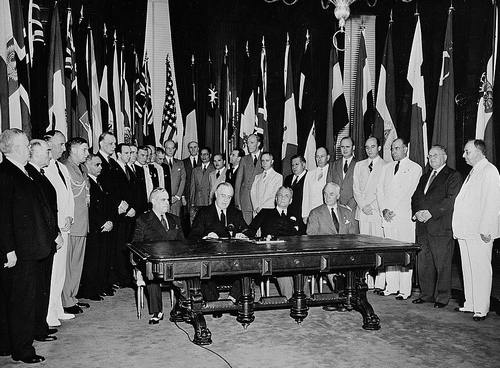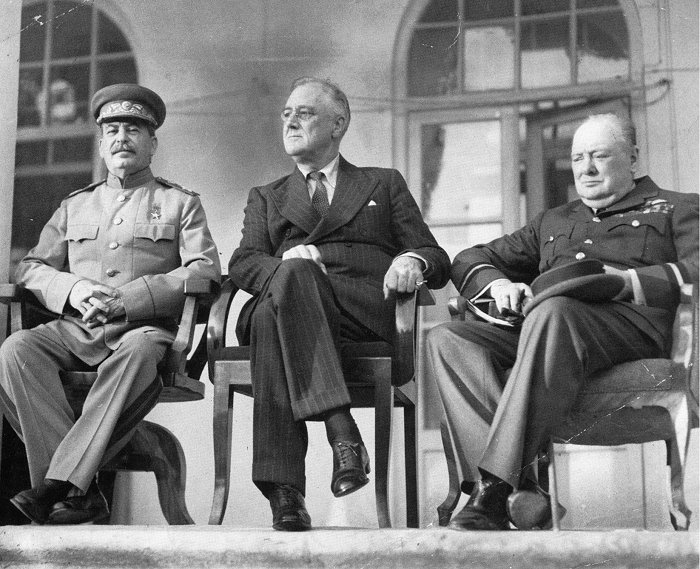First UN poster, August 1942.
Soviet flag captioned as "Russia"

Topics on this page
The United Nations
- History of the United Nations
 Cross-Link: The Treaty of Versailles and the League of Nations
Cross-Link: The Treaty of Versailles and the League of Nations
- Model UN as a Teaching Strategy
Universal Declaration of Human Rights
- Women Who Shaped the Universal Declaration
Teaching and Learning Resources
- LGBTQ Rights as Human Rights
 Cross-Link: U.S. Participation in International Organizations
Cross-Link: U.S. Participation in International Organizations
Focus Question:
What developments led to the establishment of the United Nations and the writing of the Universal Declaration of Human Rights?
The United Nations
Official website of the United Nations
Official website of women of the United Nations.
History of the United Nations, an overview from the United Nations.
United Nations Explained
Members from 26 nations across the world signing the Declaration by United Nations, January 1st, 1942.
This treaty would eventually evolve into the United Nations that we know today.

History of the United Nations
1) The United Nations was founded as a successor to the League of Nations, which was widely considered to have been ineffective in its role as an international governing body, in that it had been unable to prevent World War II.
- Some argue that the UN's major advantage over the League of Nations is its ability to maintain and deploy its member nations' armed forces as peace keepers.
- Others see such "peace keeping" as a euphemism for war and domination of weak and poor countries by the wealthy and powerful nations of the world.[3]
 |
| United Nations timeline |
Click here to learn more about the failure of the League of Nations and transition to the stronger United Nations.
2) The term "United Nations" (which appears in stanza 35 of Canto III of Byron's Childe Harold's Pilgrimage) was decided by Franklin D. Roosevelt and Winston Churchill[4] during World War II, to refer to the Allies.
Its first formal use was in the January 1, 1942 Declaration by United Nations, which committed the Allies to the principles of the Atlantic Charterand pledged them not to seek a separate peace with the Axis powers.
- Thereafter, the Allies used the term "United Nations Fighting Forces" to refer to their alliance.
In the map, Light blue are member states, Dark blue are colonies of member states, Grey are non-member states
 |
| United Nations member states at the end of 1945 |
Vijaya Lakshmi Pandit 2000 stamp of India

 Here is a link to a video about Vijaya Lakshmi Pandit, the first woman to be elected as the UN General Assembly President.
Here is a link to a video about Vijaya Lakshmi Pandit, the first woman to be elected as the UN General Assembly President.
 Go to The United Nations and Reform, a lesson plan from the PBS Newshour.
Go to The United Nations and Reform, a lesson plan from the PBS Newshour.
Click here for for information around the debate on whether to expand the permanent positions on the Security Counsel to include members like India.
- Video from CNN of the craziest moments that occurred at the UN.
Click here for a quiz about the United Nations from the official UN site.
 Model UN as a Teaching Strategy
Model UN as a Teaching Strategy
Click here for a wide range of activity guides for students.
- This website has a variety of Model UN activities students could participate in to help them better their understanding of how countries in the UN must work together to resolve issues (3).
This website provides more resources for teacher with Model UN activities.
- This website allows teachers to pick different issues students could have a Model UN meeting about, such as The Challenge of North Korea and Nuclear Energy, that could be beneficial when teaching students these different topics (4).
Focus Question: What are the main ideas in the Universal Declaration of Human Rights?
1958 Israeli stamp marking the 10th anniversary the Universal Declaration of Human Rights

 Primary Sources
Primary Sources
On December 10, 1948 the General Assembly of the United Nations adopted and proclaimed the Universal Declaration of Human Rights.
 Multimedia Resources
Multimedia Resources
- This video shows different rights given to people in the "Universal Declaration of Human Rights" in a way that would be more interesting to students than just reading it. (5).
Image on Wikimedia Commons from Building Bridges, Dorothy Cotton Institute

2) As summarized in National Geographic (December 2008) the Declaration held:
- All human beings are born free (Article 1).
- No one shall be subjected to torture or to cruel, inhuman or degrading punishment (Article 5).
- No one shall be held in slavery or servitude (Article 4).
- Everyone has the right to rest and leisure (Article 24).
- Everyone has the right to freedom of thought, conscience and religion (Article 18).
- Motherhood and childhood are entitled to special care and assistance (Article 25.2).
- Everyone has the right to education (Article 26.1).
- Everyone has the right to participate in the cultural life of the community, to enjoy the arts and to share in scientific advancement and its benefits (Article 27.1).
3) Following this historic act the Assembly called upon all Member countries to publicize the text of the Declaration and "to cause it to be disseminated, displayed, read and expounded principally in schools and other educational institutions, without distinction based on the political status of countries or territories."
Eleanor Roosevelt's Role
 |
| Eleanor Roosevelt with the Declaration, 1949 |
Eleanor Roosevelt, first lady to President Franklin D. Roosevelt, is considered the most influential member of the UN's Commission on Human Rights, the group that authored the Universal Declaration of Human Rights.
For more, see the Eleanor Roosevelt entry on the Influential Women in American History page.
 Understanding Lesbian, Gay, Bisexual and Transgender Rights as Human Rights, from the Human Rights Resource Center, University of Minnesota
Understanding Lesbian, Gay, Bisexual and Transgender Rights as Human Rights, from the Human Rights Resource Center, University of Minnesota
- Click here for information about the UN's Free and Equal movement, a global campaign by the United Nations to end homophobia and transphobia.
 Women Who Shaped the Universal Declaration
Women Who Shaped the Universal Declaration
Click here for more information about the United Nations and women.
- This page discusses the effects that the Universal Declaration of Human rights had for women, the birth of global feminism, and development goals that the United Nations has for women (i.e. international gender equality, eliminating violence against women, etc.)
 Teaching and Learning Resources
Teaching and Learning Resources



Amnesty International Human Rights Mosaics
- Amherst Middle School Teachers Kat Sherrick and Irene LaRoche created this lesson for students
- Three examples of student work to the right
Eleanor Roosevelt and the Universal Declaration of Human Rights: A Lesson Plan for Middle and Upper Grades
Universal Declaration of Human Rights from The Roosevelts by Ken Burns, PBS LearningMedia
The UN Matters: Teaching Pack. Click here for five unique lesson plans about the UN and its efforts, as well as a Model UN simulation to be completed at the end of the five lesson plans.
Click here or here for several interactive games designed by the United Nations to spread awareness about issues such as natural disasters, widespread starvation, refugees, and more.
Background information on the Creation of the United Nations
Image below shows Joseph Stalin, Franklin D. Roosevelt, Winston Churchill, Tehran Conference, 1943

1) The idea for the UN was espoused in declarations signed at the wartime Allied conferences in Moscow, Cairo, and Tehran in 1943. From August to October 1944, representatives of France, the Republic of China, the United Kingdom, the United States, and the Soviet Union met to elaborate the plans at the Dumbarton Oaks Estate in Washington, D.C. Those and later talks produced proposals outlining the purposes of the organization, its membership and organs, and arrangements to maintain international peace and security and international economic and social cooperation.
2) On 25 April 1945, the UN Conference on International Organization began in San Francisco. In addition to the governments, a number of non-governmental organizations were invited to assist in drafting the charter. The 50 nations represented at the conference signed the Charter of the United Nations two months later on 26 June. Poland had not been represented at the conference, but a place had been reserved for it among the original signatories, and it added its name later.
3) The UN came into existence on 24 October 1945, after the Charter had been ratified by the five permanent members of the UN Security Council — the Republic of China, France, the Soviet Union, the United Kingdom, and the United States — and by a majority of the other 46 signatories. That these countries are the permanent members of the Security Council, and have veto power on any Security Council resolution, reflects that they are the main victors of World War II or their successor states: the People's Republic of China replaced the Republic of China in 1971 and Russia replaced the Soviet Union in 1991.[5] Initially, the body was known as the United Nations Organization, or UNO. However, by the 1950s, English speakers were referring to it as the United Nations, or the UN.
4) When promoting the United Nations, Roosevelt insisted that it would be helpful in preventing future wars. The United Nations was established including the General Assembly of all member states, a Security Council of 5 permanent and 6 non-permanent members, an 18-member Economic and Social Council, a Trusteeship Council to control colonial territories, a Secretariat under a Secretary General, and an International Court of Justice. Roosevelt was able to gain bipartisan support for the United Charters, which seemed critical after Woodrow Wilson was unable to get the United States to join the League of Nations without bipartisan support.
- Link here to learn more about the formation of the United Nations (1).
This video explains how the United Nations was formed with the goal of preventing another world war. The video explains the different aspects of the United Nations and the countries involved in it. It goes into detail describing the General Assembly and the Security Council. It also introduces the "United Declaration of Human Rights" and talks about the kinds of issues the UN works to resolve (2).
(1) https://history.state.gov/milestones/1937-1945/un
(2) https://www.youtube.com/watch?v=QoIafzc0k74
(3) http://www.unausa.org/global-classrooms-model-un/for-educators/resources/activity-guides
(4) https://www.youtube.com/watch?v=hTlrSYbCbHE
(5) https://www.youtube.com/watch?v=hTlrSYbCbHE

![]() Understanding Lesbian, Gay, Bisexual and Transgender Rights as Human Rights, from the Human Rights Resource Center, University of Minnesota
Understanding Lesbian, Gay, Bisexual and Transgender Rights as Human Rights, from the Human Rights Resource Center, University of Minnesota![]() Women Who Shaped the Universal Declaration
Women Who Shaped the Universal Declaration
Comments (0)
You don't have permission to comment on this page.